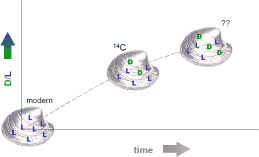In most instances, the exte

nt of amino acid racemization (
AAR) in fossils is interpreted in terms of relative ages. If the reaction rate can be calibrated using an independently dated nearby site with similar thermal history, absolute dates can be inferred through calibration. Resolution depends on the average temperature: warmer sites have better resolution and less overall time range. As a rule of thumb, sites with a mean annual temperature of 30°C have a maximum range of 200 ka and resolution of about 10 ka; sites at 10°C have a maximum age range of ~2 m.y., and resolution generally about 20% of the age; at -10°C the reaction has a maximum age of ~10 m.y., and a correspondingly coarser resolution.
 nt of amino acid racemization (AAR) in fossils is interpreted in terms of relative ages. If the reaction rate can be calibrated using an independently dated nearby site with similar thermal history, absolute dates can be inferred through calibration. Resolution depends on the average temperature: warmer sites have better resolution and less overall time range. As a rule of thumb, sites with a mean annual temperature of 30°C have a maximum range of 200 ka and resolution of about 10 ka; sites at 10°C have a maximum age range of ~2 m.y., and resolution generally about 20% of the age; at -10°C the reaction has a maximum age of ~10 m.y., and a correspondingly coarser resolution.
nt of amino acid racemization (AAR) in fossils is interpreted in terms of relative ages. If the reaction rate can be calibrated using an independently dated nearby site with similar thermal history, absolute dates can be inferred through calibration. Resolution depends on the average temperature: warmer sites have better resolution and less overall time range. As a rule of thumb, sites with a mean annual temperature of 30°C have a maximum range of 200 ka and resolution of about 10 ka; sites at 10°C have a maximum age range of ~2 m.y., and resolution generally about 20% of the age; at -10°C the reaction has a maximum age of ~10 m.y., and a correspondingly coarser resolution.

 nt of amino acid racemization (AAR) in fossils is interpreted in terms of relative ages. If the reaction rate can be calibrated using an independently dated nearby site with similar thermal history, absolute dates can be inferred through calibration. Resolution depends on the average temperature: warmer sites have better resolution and less overall time range. As a rule of thumb, sites with a mean annual temperature of 30°C have a maximum range of 200 ka and resolution of about 10 ka; sites at 10°C have a maximum age range of ~2 m.y., and resolution generally about 20% of the age; at -10°C the reaction has a maximum age of ~10 m.y., and a correspondingly coarser resolution.
nt of amino acid racemization (AAR) in fossils is interpreted in terms of relative ages. If the reaction rate can be calibrated using an independently dated nearby site with similar thermal history, absolute dates can be inferred through calibration. Resolution depends on the average temperature: warmer sites have better resolution and less overall time range. As a rule of thumb, sites with a mean annual temperature of 30°C have a maximum range of 200 ka and resolution of about 10 ka; sites at 10°C have a maximum age range of ~2 m.y., and resolution generally about 20% of the age; at -10°C the reaction has a maximum age of ~10 m.y., and a correspondingly coarser resolution.